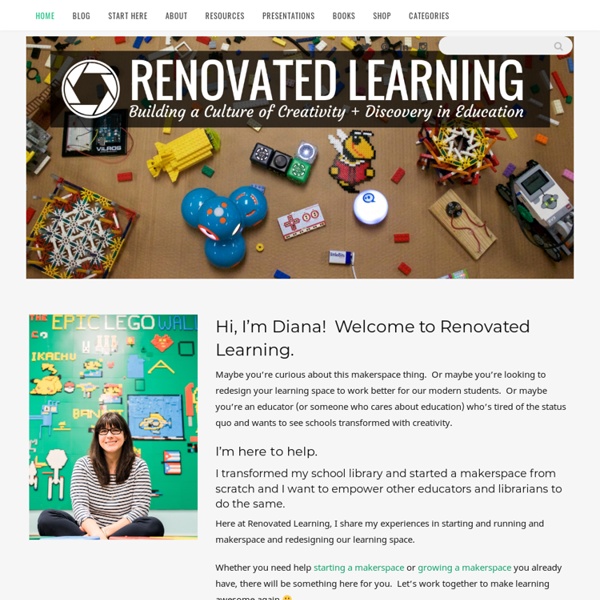



Introducing Design Thinking to Elementary Learners Design thinking is an approach to learning that includes considering real-world problems, research, analysis, conceiving original ideas, lots of experimentation, and sometimes building things by hand. The projects teach students how to make a stable product, use tools, think about the needs of another, solve challenges, overcome setbacks and stay motivated on a long-term problem. The projects also teach students to build on the ideas of others, vet sources, generate questions, deeply analyze topics, and think creatively and analytically. Many of those same qualities are goals of the Common Core State Standards.
Advocating for Makerspaces in Libraries Since I first started my Makerspace at Stewart Middle Magnet School in January 2014, I have received a lot of positive feedback. I’ve given talks, presented at conferences, and shared about our experiences through my blog and through social media. Some of the questions I am most frequently asked are: Why should makerspaces be in the library? Why not just convert a classroom into a STEM lab? In a similar vein, I often hear from librarians who are struggling to get their administration/teachers/community to understand the rationale for having a Makerspace in their library. Top School Library Blogs One look at the titles of blogs narrated by school librarians reveals the evolution of a profession within an institution that is at a pivotal point. Charged with the vital duty of promoting digital literacy, today’s librarians are daring, unquiet, sassy and definitely e-literate. This list features the top school library blogs ordered by website popularity metrics and social media engagement including the number of websites that link to a blog and number of followers on Twitter.
Computational Thinking Across the Curriculum Algorithmic Thinking Students demonstrate algorithmic thinking whenever they create or use a well-defined series of steps to achieve a desired outcome. In our sixth-grade math class, for example, students identify and plot a set of ordered pairs on a coordinate plane to re-create a piece of art they’ve made. Students practice the algorithm for Punnett squares by refashioning themselves as cartoon babies, meticulously crossing their genotypes to create endless generations of children. In orchestra, students learn about the history of algorithmic music composition, from Mozart’s dice music to Emily Howell, a computer program created by David Cope, to modern, all-robot bands.
Designing a School Makerspace Makerspaces, STEAM labs and fab labs are popping up in schools across the country. Makerspaces provide hands-on, creative ways to encourage students to design, experiment, build and invent as they deeply engage in science, engineering and tinkering. A makerspace is not solely a science lab, woodshop, computer lab or art room, but it may contain elements found in all of these familiar spaces. Therefore, it must be designed to accommodate a wide range of activities, tools and materials. Diversity and cross-pollination of activities are critical to the design, making and exploration process, and they are what set makerspaces and STEAM labs apart from single-use spaces.
Teacher-Librarians Here's a MEGALIST for my fellow media specialists/teacher-librarians. It's taken a while to gather all the information and I will continue to add to this page. Currently there are close to 185 sites listed. There is SO MUCH information out there! Design Thinking Process and UDL Planning Tool Bringing Makerspaces into Classrooms to meet STEM and STEAM Post by Jackie Gerstein, Ed.D. @jackiegerstein, and Barbara Bray @bbray27 is also cross-posted at If there is a makerspace in your school, it may be down the hall, in the library, or in another building. If there is someone other than the teacher managing the makerspace or there is a schedule for the school, your kids may only be able to use it once a week or month. Some makerspace activities may be focusing on how to use the resources available and may not be connecting the activities to the curriculum or around a real world problem.
Starting a School Makerspace from Scratch With the National Week of Making behind us, you might be ready to start a makerspace in your school -- but not know where to start. Will purchasing a costly 3D printer and the latest robotics kit ensure learning and maker success? What are some steps to starting a successful makerspace from scratch? Step 1: Immerse Yourself in Maker Education
AudioSynced In conjunction with Abby (the) Librarian, STACKED hosts a monthly meme to celebrate all things audiobook. On the first of each month, we rotate the blogger round up of audiobook news, reviews, and more shared in the blogosphere in the last month. We host on odd-numbered months.